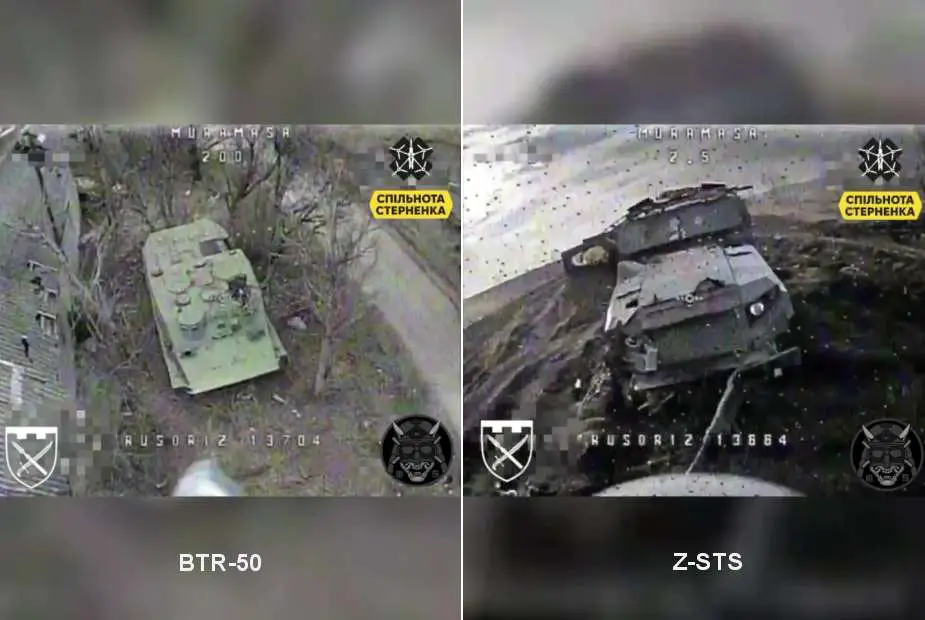Ukrainian FPV drones hit both old BTR-50 and modern Z-STS Russian armored vehicles
As reported by Sternenko on March 13, 2024, Ukrainian operators of FPV drones from the 109th separate brigade have achieved success in locating and targeting several Russian vehicles. Among the targets successfully hit were a BTR-50, an armored personnel carrier dating back to the Stalin era, and a recent Z-STS Akhmat mine-resistant ambush-protected (MRAP) vehicle, which was unveiled in 2022.
Follow Army Recognition on Google News at this link

Ukrainian FPV drones seem to be effective against both old and modern Russian armored vehicles. (Picture source: Telegram/Sternenko)
Manufactured by the Remdiesel Plant, the Z-STS "Akhmat" MRAP vehicle was introduced in 2022 to meet the security needs of the Chechen security services, necessitating a rapidly producible and deployable transport solution. Built on the chassis of the KamAZ-5350 6x6 truck, the Z-STS utilizes a frame system instead of a monocoque body, simplifying production and enabling the interchangeability of different body types on the same chassis, albeit at the cost of reduced load-bearing capacity.
Although lacking some of the advanced features found in the Kamaz Typhoon vehicles, the Z-STS is designed to provide a comparable level of protection against 7.62 mm caliber rounds. Its V-shaped undercarriage is intended to protect against blasts equivalent to 6 kg of TNT, with safety seats incorporated to enhance occupant protection. The vehicle's design, separating the crew area from the vehicle's front, allows for the installation of weapon systems such as a machine gun through a roof hatch. Additionally, it can be equipped with the Arbalet-DM module, which features a 12.7-mm Kord machine gun and surveillance devices.
Measuring 8.43 m in length, 2.55 m in width, and 3.1 m in height, with a ground clearance of 390 mm, the Z-STS Akhmat showcases notable off-road capabilities, capable of ascending slopes with a minimum 30-degree incline and traversing water up to 1.75 meters deep. Powered by a 260-horsepower engine, the Akhmat can reach a maximum speed of 90 km/h on highways despite its weight of up to 18,000 kg.
On the other hand, the BTR-50, originating in 1949 under the late Stalin era, served as the first Soviet armored personnel carrier. Designed to transport troops and cargo, the BTR-50 showcased amphibious capabilities, enabling the movement of up to 20 soldiers across water obstacles. Over its operational history, the BTR-50 underwent numerous modifications to address vulnerabilities, evolving into variants like the BTR-50PK with enhanced armament and protective features.
Despite its age, the BTR-50 has been reconsidered for use by Russia since the start of the Russian invasion of Ukraine. Its enduring relevance can be attributed to its capacity to carry a significant number of troops or cargo, surpassing newer models like the BTR-80 or BTR-90, as well as its off-road and amphibious capabilities. The BTR-50’s design also allows for relatively straightforward maintenance, an important factor in conflict zones like Ukraine. This aspect might explain the Russian Forces' revisitation of their entire arsenal, as the demands of wartime can necessitate the reactivation of formerly retired assets, especially when there are no readily available alternatives to fulfill the military's needs.























